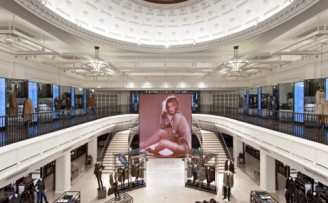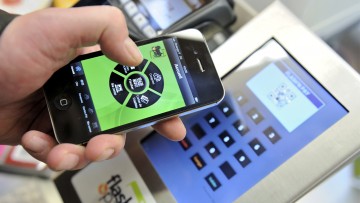According to research by digital performance firm Dynatrace, nearly a third of UK consumers shop through a combination of online, mobile and in-store channels. As such, it’s important to understand how your target customers are using technology in the purchasing pathway. Each business will be different but our infographic – The New Purchasing Pathway – provides a useful introduction:
The increase in online touchpoints gives retailers an opportunity to track and understand consumers’ behaviour. But knowing how to use the wealth of data available in a meaningful way is not easy. “Retailers are struggling to keep up with rapidly changing consumer demands,” says Andrew Long, head of IT strategy at Accenture UK. “The digital transformation has a long way to go and its impact will affect everyone and everything – businesses are going to have a major challenge keeping up with the pace.”
Mastering omni-channel

Burberry World Live, Regent Street
The retailers succeeding in the new omni-channel world are those that treat online and in-store as complimentary channels, rather than competing forces. One of the leaders in the luxury space is Burberry. Its flagship Regent Street store, dubbed “Burberry World Live”, brings digital experiences in store, while its digital experience affords customers a more rich interaction with the product than is expected of online platforms. Art of the Trench, for instance, lets customers download pictures of themselves in the iconic Burberry trench coat.
Their investment in digital is fostering loyalty in current customers and aspirational potential customers. Burberry boasts over 17 million fans on Facebook and 5.6 million Twitter followers, giving it a huge community of online advocates.
Building loyalty through personalisation
When it comes to ensuring loyalty, mobiles and wearables are only going to become more important. Integrating a loyalty scheme with a mobile app means retailers can use the valuable stream of data captured by the user’s device. This means they can send targeted offers in real time. It’s this personalisation that can drive success, as Origin digital strategist Georgia Marshall-Brown explains: “Personalised experiences are more engaging, entertaining, memorable and inspiring for audiences, which ultimately drives satisfaction, sales and loyalty. The results speak for themselves with 35 per cent of Amazon’s revenue generated by its recommendation engine”.

Add to this the growing trend in mobile payments, and you start to build a picture of how big a part mobile is set to play in consumers’ behaviour in 2016. “The massive increase in mobile payments offers a real point of differentiation for mobile loyalty,” says Ben Perkins, head of consumer business research at Deloitte. “You can make a promotion instant and context relevant, and not just based on previous purchasing behaviour.”
Demonstrating added value
 New tech provides an opportunity for retailers but it’s important to establish how it will add value to your customers. Dan Wagner, chief executive of Powa Technologies, says: “Real value is what defines consumer patterns. Consumers are looking to make informed purchases that can be completed via their smartphones easily and securely. Being constantly bombarded by individual mobile commerce and payments applications has only complicated further an already saturated market. Users experience the same frustrations looking at their smartphones being overcrowded with apps of limited scope and reach as looking at their wallets or pockets being full of credit and loyalty cards that can only be used in certain stores.
New tech provides an opportunity for retailers but it’s important to establish how it will add value to your customers. Dan Wagner, chief executive of Powa Technologies, says: “Real value is what defines consumer patterns. Consumers are looking to make informed purchases that can be completed via their smartphones easily and securely. Being constantly bombarded by individual mobile commerce and payments applications has only complicated further an already saturated market. Users experience the same frustrations looking at their smartphones being overcrowded with apps of limited scope and reach as looking at their wallets or pockets being full of credit and loyalty cards that can only be used in certain stores.
He warns that “users do not want one more app – they need the right tool that provides real solutions to their needs.” It’s a question business leaders should ask themselves before jumping on the latest tech bandwagon – will this provide a solution to a genuine need?
